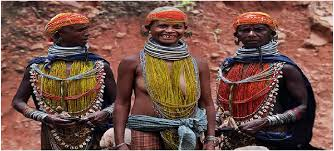Odisha: Time to Take U-Turn to Preserve Perishing Tribal Culture in Malkangiri Hills

At the top-most peak of the Bonda hills in Malkangiri district in Odisha, lies one of the 32 Bonda tribe settlements, that is Kichakpada.
After a 2.5 kilometer-long and stiff climb up from Andrabahal that nestles with the foothill settlements running down to Mudulipada, the plain area, where too the Bondas live, is known as Lower Bondas.
The Upper Bondas have a population of 6,700, who are isolated from mainstream Indian society, while those in the Lower Bonda, with a population of 17,000, live close to the mainstream population. The people there now wear a non-tribal look.
They (the Upper Bondas) live in complete isolation from the normal habitats and are known for their love of living in their own domain, in their own way.

While travelling from the Koraput district town headquarter toward Malkangiri, our group took an abrupt diversion on the left at Khairput block, which is supposed to be the gateway into the Bonda hills.
When the Sun sets, the entire hill remains clad in a hazy apron with slatey smoke billowing from within the thick foliage harbouring the settlements.
As we climb up closer to the sylvan beauty, one thing that sticks out like a sore thumb is the pitiable health facilities in these hills.
We saw a man being carried down the hilly track to a place called Mudulipada where there is a small health centre with a compounder, and an occasional doctor.
Although the tribe, one of the most primitive ones in the country, has always lived in complete intimacy with nature, with herbs, roots and fruits serving as palliatives against ailments, with the changing climatic pattern, they have started facing the invasion of new diseases, posing new challenges.
What is starkly missing in these woods are basic health facilities, like primary health aid and a sense of hygiene.
Instances in the recent past expose the yawning gap between what the government claims and what is available to these hilly habitants, mainly the Bondas.
Inaccessible terrain, jungles, water bodies stand in between accessible healthcare for these people.
Health services are pitiably absent and lack of primary facilities and transportation deprives this tribe of their lives more often than not.
Dumbru Markani said he lost his wife in 2022. She had to be physically carried on a cot down the hills for 5 km down to Mudulipada’s primary health centre for delivery, when she was in acute pain. She died much before reaching there.
So many such incidents take place through the year but go unreported.
The population growth is stagnant for many years, mainly among the Upper Bondas.
Suman Sumari (name changed) was having unbearable pain in the lower part of the belly. Her father’s journey with her was so gruelling. Her pain was increasing as her father and a neighbour carried her physically from Kumruput down to Kahirput. She succumbed much before they could reach the CHC (Community Health Centre) at Khairput, said some local persons.
Bonda is not only one of the most (supposedly second-most primitive) tribes in India, it is also among the most under-privileged.

“The tribe resides in remote hilly terrains and qualifies as “vulnerable” because of their stagnant population, low literacy level and pre-agricultural level of knowhow” said S N Sahu, a noted scholar on Bonda tribe
While health parameters remain a major area of concern among these tribes, in many of such villages, remote geography and limited communication access also impact healthcare.
“Insecure livelihoods and lack of access to government services have significantly impacted the health of these tribes” Sahu added.
Geographic isolation is obviously one major bottleneck and to address such issues, the state government had created the Bonda Development Agency (BDA), which was supposedly a single-window system that was supposed to reach out to the deep interiors in the Upper Bonda settlements. But this has not been possible, as the BDA lacks infrastructure, including trained manpower.
Most of the villages are inaccessible in the sense that there are only narrow strips that cut through the hilly tracks where only two wheelers can go. After the sun sets, it is a nightmare to handle a sick person.
"Normally it takes us over three hours to cover the distance on foot. There is no other option. Ambulances cannot reach us and we have to cover the distance on our own”, said Dombru Sirsa, former MLA. “Although I have proposed widening of climbing tracks many times and creation of mobile health services, such proposals are still to be implemented,” he added.
What is feared is that the population of Upper Bondas remaining stagnant and mortality increases, mainly infant, many of them are trying to relocate to lower areas, like Mudulipada and around, where they slowly shed their customs, clothes, lifestyle, values, and to merge with the mainstream.
It is feared that this may lead this tribe one day to become a museum showpiece. “A tribe that is believed to have come to Odisha from South Africa 60,000 years ago and became forest settlers, are required to be preserved” said Sahu.
The writer is a freelance journalist based in Odisha.
Get the latest reports & analysis with people's perspective on Protests, movements & deep analytical videos, discussions of the current affairs in your Telegram app. Subscribe to NewsClick's Telegram channel & get Real-Time updates on stories, as they get published on our website.
























